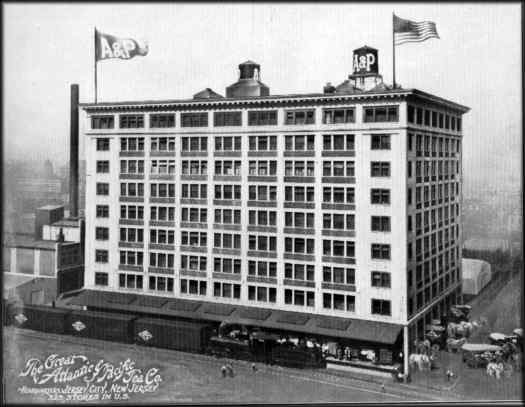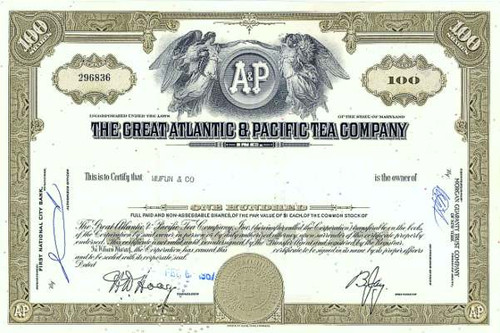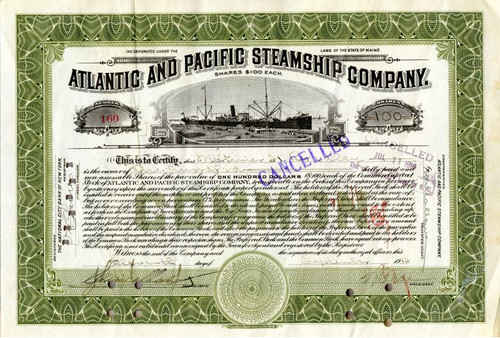Beautifully engraved SCARCE low serial number certificate from the Great Atlantic and Pacific Tea Company, Inc. issued in 1916. This historic document was printed by the American Banknote Company and has an ornate border around it. This item is hand signed by the Company's President ( George Huntington Hartford )and its Treasurer ( George Ludlum Hartford ) and is over 103 years old. 
Great Atlantic and Pacific Tea Company's Early Operations George Huntington Hartford was 26 years old when he and partner George Gilman experimented with a unique concept that would bring them great success. At the time, tea was an extremely popular item being sold for $1 per pound. But the two businessmen figured that buying tea directly from the ships and eliminating middlemen could trim the price to a more customer-friendly 30¢. In 1859, they opened their first store on Vesey Street in Manhattan. The store's ornate interior and flaming red facade were only the beginning of the partners' elaborate plan to expand their business and attract customers. Their early marketing efforts included handing out free lithographs, advertising in renowned publications, and toting the store name on a red wagon drawn by eight dapple grey horses. On the profits and publicity generated by the first store, more stores soon followed in surrounding towns and cities. In the 1860s and '70s, with the company's first stores trading primarily in tea, coffee and spices, the reputation of the young company began to spread. The company's name changed to the Great Atlantic & Pacific Tea Company, and Gilman sold his share of the company and retired on the profits. With Hartford acting as sole owner, he soon dubbed his own brand of coffee, Eight O'Clock Breakfast Coffee, whose popularity and profits soared. But it was the appointment of his sons George and John A. Hartford to leadership positions in the company that helped A&P become one of America's most successful businesses. George authored one of A&P's earliest successes, when he discovered that A&P could keep costs down by manufacturing its own products. This philosophy continues today with A&P's successful private label products such as America's Choice, Master Choice, Health Pride and the most popular, Eight O'Clock Coffee. However, it was John's experiment that led A&P to national prominence early in the 20th century. In 1912, he persuaded both his father and brother George to try a new cash and carry "economy" store, as opposed to deliveries and charge accounts that were popular at the time. Competing against one of the company's most profitable stores nearby, the tiny store drove the larger one out of business in just six months! Within two years, 1,600 of the new economy stores opened, an average of almost three per day. By 1916, A&P's sales had more than doubled, from $31 million to $76 million, and the elder John Hartford completely turned the business over to his two sons. Under the Hartfords' customer-oriented, price-driven philosophy, A&P had 13,961 stores and sales of $437 million by 1925. Their business approach even enabled them to survive Wall Street's crash in 1929 unscathed. The advent of "super" markets in the early 1930's briefly threatened to unravel the A&P "empire." But the Hartford's responded by closing their economy-style stores and opening new supermarkets - nearly six closings per new store opening! But store volume grew so much during this time that A&P's sales, profits, payroll and employees continued to rise. A&P's rise happened not only internally, but externally as well. Through various advertising efforts and publicity, the company name grew to one of the most well-known in America prior to World War II. A&P entertained the nation with radio shows featuring the "A&P Red Circle Orchestra," Harry Horlick and the A&P Gypsies. In 1937, A&P launched Woman's Day magazine, featuring recipes, decorating tips, child care pointers and more. By 1944, the magazine had a monthly circulation of 3 million copies, and under A&P's ownership it became one of the nation's ten best-selling magazines. The company was also a primary participant at World's Fair expositions, Kate Smith acted as A&P's spokesperson for many years, and Commander Byrd further enhanced the company's reputation when he bought 2 1/2 tons of A&P Bokar Coffee for his Antarctic expedition, claiming he had to "have the best." And by this time, Eight O'Clock Coffee was the largest-selling coffee in the entire world! One of every four cups of coffee consumed in America came from A&P! By 1950, with annual sales of $2.9 billion, A&P was outsold only by General Motors. And of every dollar spent on food in the U.S. at that time, approximately 10 (cents) passed over A&P counters. The rise of competition, the presence of US regulatory restrictions on corporate size, and cost cutting led to many store closings during the 1960s and '70s. But during the 1980s, the company streamlined itself and set about the task of regaining and expanding its market share. Through expansion into both new and existing markets, as well as the acquisition of several well-known grocery chains within the U.S., A&P solidified its foundation for years to come. A&P's resurgence began in the early '80s with the addition of Wisconsin-based Kohl's Food Stores in October 1983. This was followed in rapid succession by the acquisition of several well-known companies that immediately established or re-affirmed a major market presence for A&P. The operation of Eastern seaboard-based Super Fresh was expanded and enhanced, and the purchase of Dominion Stores Limited in 1985 boosted the company's Canadian presence. A year later, the company augmented its New York market share by obtaining both the Shopwell/Food Emporium and Waldbaum's chains. And in early 1989, metropolitan Detroit-based Borman's, operating under the name Farmer Jack, became a part of A&P's operations. Added grocery items to stores late in the 19th century. Opened 10,000th store in 1923, using the Economy Store format seen across America since 1913. Number of stores peaked in 1930 with 15,737 (annual sales of $1.07 billion). Conversion to supermarkets reduced store count to 4150 by 1955.

Great Atlantic and Pacific Tea Company's Early Operations













